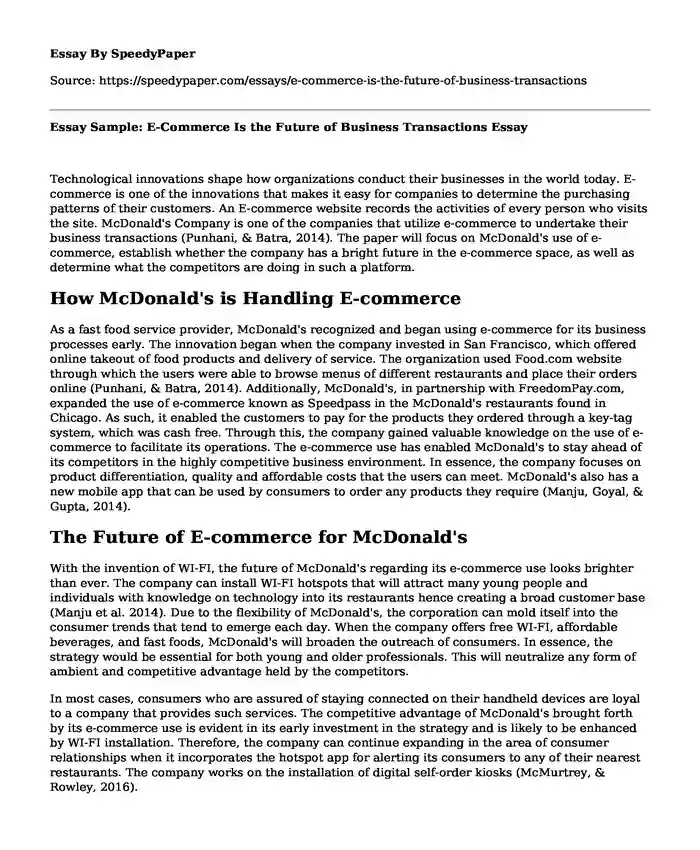
| Type of paper: | Essay |
| Categories: | Company Internet Information technologies Business strategy |
| Pages: | 3 |
| Wordcount: | 703 words |
Technological innovations shape how organizations conduct their businesses in the world today. E-commerce is one of the innovations that makes it easy for companies to determine the purchasing patterns of their customers. An E-commerce website records the activities of every person who visits the site. McDonald's Company is one of the companies that utilize e-commerce to undertake their business transactions (Punhani, & Batra, 2014). The paper will focus on McDonald's use of e-commerce, establish whether the company has a bright future in the e-commerce space, as well as determine what the competitors are doing in such a platform.
How McDonald's is Handling E-commerce
As a fast food service provider, McDonald's recognized and began using e-commerce for its business processes early. The innovation began when the company invested in San Francisco, which offered online takeout of food products and delivery of service. The organization used Food.com website through which the users were able to browse menus of different restaurants and place their orders online (Punhani, & Batra, 2014). Additionally, McDonald's, in partnership with FreedomPay.com, expanded the use of e-commerce known as Speedpass in the McDonald's restaurants found in Chicago. As such, it enabled the customers to pay for the products they ordered through a key-tag system, which was cash free. Through this, the company gained valuable knowledge on the use of e-commerce to facilitate its operations. The e-commerce use has enabled McDonald's to stay ahead of its competitors in the highly competitive business environment. In essence, the company focuses on product differentiation, quality and affordable costs that the users can meet. McDonald's also has a new mobile app that can be used by consumers to order any products they require (Manju, Goyal, & Gupta, 2014).
The Future of E-commerce for McDonald's
With the invention of WI-FI, the future of McDonald's regarding its e-commerce use looks brighter than ever. The company can install WI-FI hotspots that will attract many young people and individuals with knowledge on technology into its restaurants hence creating a broad customer base (Manju et al. 2014). Due to the flexibility of McDonald's, the corporation can mold itself into the consumer trends that tend to emerge each day. When the company offers free WI-FI, affordable beverages, and fast foods, McDonald's will broaden the outreach of consumers. In essence, the strategy would be essential for both young and older professionals. This will neutralize any form of ambient and competitive advantage held by the competitors.
In most cases, consumers who are assured of staying connected on their handheld devices are loyal to a company that provides such services. The competitive advantage of McDonald's brought forth by its e-commerce use is evident in its early investment in the strategy and is likely to be enhanced by WI-FI installation. Therefore, the company can continue expanding in the area of consumer relationships when it incorporates the hotspot app for alerting its consumers to any of their nearest restaurants. The company works on the installation of digital self-order kiosks (McMurtrey, & Rowley, 2016).
What McDonald's Competitors Are Doing in E-Commerce
One of the major competitors of McDonald's is Domino's, which uses digital ordering as part of its e-commerce strategy. With the introduction of this strategy, the company realized a substantial increase in its stock as the users can order fast foods through Twitter and Facebook platforms. Another competitor is the Dunkin' Donuts that has considered the need to respond to high demands from customers by moving from digital services and the use of mobile apps to AWS as the provider of cloud infrastructure. However, McDonald's still has a sustainable competitive advantage even with the e-commerce used by its rival companies (McMurtrey, & Rowley, 2016).
References
Manju, M., Goyal, R., & Gupta, P. (2014). E-commerce: A Fortune for the Prosperity of Business. Global Journal of Business Management and Information Technology, 4(1), 25-31. Retrieved from https://www.ripublication.com/gjbmit/gjbmitv4n1_04.pdf
McMurtrey, M. E., & Rowley, B. (2016). McDonald's and the Triple Bottom Line: A Case Study of Corporate Sustainability. Journal of Strategic Innovation and Sustainability, 11(1). Retrieved from https://doi.org/10.33423/jsis.v11i1.812
Punhani, R., & Batra, S. (2014). Understanding Cultural Variations of E-Commerce Websites in A Global Framework. Global Journal of Finance and Management, 6(3), 275-280. Retrieved from https://www.ripublication.com/gjfm-spl/gjfmv6n3_14.pdf
Cite this page
Essay Sample: E-Commerce Is the Future of Business Transactions. (2022, Dec 23). Retrieved from https://speedypaper.com/essays/e-commerce-is-the-future-of-business-transactions
Request Removal
If you are the original author of this essay and no longer wish to have it published on the SpeedyPaper website, please click below to request its removal:
- Free Essay Sample on Being Materialistic
- Essay Example on a Cluster Differentiation Antigen Expressed on the Immune B Cell
- Free Essay on Cheap Solution of Acoustic Treatment for Small Church
- Free Essay: The Journey of the Magi Analysis
- Essay Example: Wilderness, Climate Change, and Traditional Knowledge
- Paper Example on Race and Technology
- Paper Example. Patterns of Othering
Popular categories




